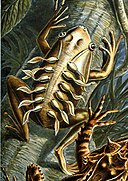Файл:Haeckel Batrachia.jpg

Алдан карауның зурлыгы: 424 × 599 нокта. Башка ачыклык: 170 × 240 нокта | 339 × 480 нокта | 543 × 768 нокта | 724 × 1024 нокта | 2323 × 3284 нокта.
Төп файл (2323 × 3284 нокта, файл зурлыгы: 2,17 Мб, MIME төре: image/jpeg)
Файл тарихы
Файлның нинди булганлыгын күрү өчен «дата/вакыт» дигәненә басыгыз.
| Дата/вакыт | Кече рәсем | Үлчәмнәре | Кулланучы | Искәрмә | |
|---|---|---|---|---|---|
| агымдагы | 24 фев 2006, 03:17 |  | 2323 × 3284 (2,17 Мб) | Ragesoss | improve version, based on same original scan |
| 11 фев 2006, 00:22 |  | 2318 × 3280 (2,21 Мб) | Ragesoss | The 68th plate from Ernst Haeckel's 1899 ''Kunstformen der Natur'', depicting frogs classified as Batrachia. Category:Ernst Haeckel |
Файлны куллану
Әлеге файл киләсе битне куллана:
Файлның гомуми кулланышы
Әлеге файл аста бирелгән викиларда куллана:
- arz.wikipedia.org проектында куллану
- ast.wikipedia.org проектында куллану
- az.wikipedia.org проектында куллану
- ban.wikipedia.org проектында куллану
- be.wikipedia.org проектында куллану
- bg.wikipedia.org проектында куллану
- ca.wikipedia.org проектында куллану
- ca.wikibooks.org проектында куллану
- ceb.wikipedia.org проектында куллану
- ckb.wikipedia.org проектында куллану
- dag.wikipedia.org проектында куллану
- de.wikipedia.org проектында куллану
- din.wikipedia.org проектында куллану
- el.wikipedia.org проектында куллану
- en.wikipedia.org проектында куллану
- Wikipedia:Featured pictures thumbs/04
- Wikipedia:Picture of the day/June 2006
- User:Ragesoss/Haeckel
- Wikipedia:Featured picture candidates/Haeckel Batrachia.jpg
- Wikipedia:Wikipedia Signpost/2006-03-13/Features and admins
- Wikipedia:Featured picture candidates/March-2006
- Talk:Frog/Archive 3
- User talk:Ragesoss/Archive1
- Wikipedia:Picture of the day/June 12, 2006
- Wikipedia:POTD/June 12, 2006
- Wikipedia:POTD column/June 12, 2006
- Wikipedia:POTD row/June 12, 2006
- Kunstformen der Natur
- User:Samsara/Frog/Stable
- Wikipedia:WikiProject Germany/Gallery
- User:Froggyyes~enwiki
- Wikipedia:Featured pictures/Animals/Amphibians
- Unclean spirit
- User:Xophist/s5
- Wikipedia:Wikipedia Signpost/2006-03-13/SPV
- Portal:Amphibians
- Talk:Alfred Russel Wallace/Archive 1
- Portal:Amphibians/Selected picture
- User:The Transhumanist/Sandbox144
- Template:POTD/2006-06-12
Бу файлның гомуми кулланышын карау.






